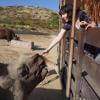Hi Wildlabbers,
We're trying out a new way to bring together all of the cool #tech4wildlife content we find on Twitter, and our community here on WILDLABS. Every week, our team will share a handful of our favorite news, opportunities, and highlights from conservation tech social media here in this thread.
We also welcome the community to share your favorite posts of the week!
Brazilian frog believed ‘extinct’ for 50+ years, found with eDNA testing: https://t.co/yg579bb7eN pic.twitter.com/pHcWvXmhu6
— Mongabay (@mongabay) October 7, 2020
What exciting things have you encountered on Twitter this week that we should share with the wider WILDLABS community??
-Ellie
9 October 2020 9:58am
Are we just supposed to pick one? I'm taking three..
1. Neat instructional video from @cameratraps1 demoing how to fix sulfated camera traps
Any of your #cametrap is broken because of sulfated batteries?
— cameratraps (@cameratraps1) October 5, 2020
Do you think that you can't solve this problem?
Here a simple and cheap solution!!@BrowningCams @WILDLABSNET @cameratrapsperu @SumatraCTP @mammalnet_eu @camtraplive @CameraTrapSue @ZSLconservation @palombar_pt pic.twitter.com/BHncyJKejR
2. African Bioacoustics community and The Conservation Symposium joining forces to combine their virtual conferences:
A (probable) first for SA and one of the benefits of a virtual conference! Conflicting conferences? Nah - just do a crossover event!! . @AfriBioacoustic x @conservationsym = some very cool #science and #scicomm in action. Really glad we could pull this off. Speakers list here .. https://t.co/y7OaYmuUXw
— seasearch (@seasearchafrica) October 5, 2020
3. Finally, I just enjoyed the r chatter and some commiserations in this thread -
My conservative estimate comes out to 10,400. That makes me an expert, right? Malcom Gladwell says it does.
— Ben Augustine (@BenCAugustine) October 7, 2020
Imagine if R had 'hours played' when you opened it https://t.co/D9hMIfuHMe
— Dr Dani Rabaiotti (@DaniRabaiotti) October 7, 2020
Happy Friday everyone!
Steph
15 October 2020 10:18pm
I had such a hard time choosing this week!! Here's a handful of my favorites:
First, it was so nice to see the condor cams back on after recent wildfires took down the entire system! The streaming camera system is so complex and it's incredible that their team got it back up so quickly.
The Iniko Condor Cam is back online! After this endangered chick survived the devastating California Dolan Fire, we were able to get the nest cam equipment back up and running. Now we can watch Iniko's nest until fledge time pic.twitter.com/N1z7fMQaAN
— explore.org (@exploreorg) October 9, 2020
Also very exciting to see WILDLABS on Akiba's hardware as he and Meredith Palmer prep their Arduino-based HWC solution!
@Steph_ODonnell FYI Hard to see, but here's the silkscreen of the board that we're sending out for testing in the Human-Elephant conflict issues in Congo: pic.twitter.com/u6IR76ryOT
— akiba (@freaklabs) October 10, 2020
I also loved Andrew Digby's series of tweets while out in the field tagging endangered kakapos - very cool to see this tracking operation in action! Every single kakapo is tagged and tracked, and it's so interesting to see how they manage the ongoing maintenance and replacements of their transmitters when dealing with pretty elusive birds.
Rere being released on Whenua Hou after her transmitter change today. She wasn’t too impressed with the experience, but now won’t be bothered for another year. We look forward to when we don’t need a transmitter on every #kakapo. #conservation #parrots pic.twitter.com/G7RaQ8Oy3X
— Dr Andrew Digby (@takapodigs) October 13, 2020
And lastly, this camera trap footage of snow leopards was just cute!
Just some snow leopard cubs to make your day a bit better. Don’t forget to turn on the sound to hear them sniff the camera trap #tech4wildlife https://t.co/mByVX75OMe
— Ineke Knot (@ieknot) September 20, 2020
23 October 2020 9:35pm
Time for another Friday's #tech4wildlife Twitter highlight selection! My favorite thing I came across on Twitter this week was this very cool 3D flight path visualisation from eagle tracking data:
Eagle data spirals!! This year we have been tracking four adult Tasmanian wedge-tailed eagles in neighbouring territories. This video shows one week of the movements from Bob (blue), Bonnie (green), Malu (orange), and Stella (pink). #wedgetailedeagle pic.twitter.com/jxVTNPiB5r
— James Pay (@JamesMPay) October 19, 2020
So amazing to see tracking data from this perspective!
6 November 2020 11:21pm
Well, we all know that this week on Twitter has been crazy! But there was still plenty of cool #tech4wildlife news popping up this week as well - here are a few of our favorites:
It's always great to see updates from our friends at BearID, a project that started as a WILDLABS collaboration! They're got a new paper out now that is worth a read if you're interested in how deep learning can be used for conservation.WILDLABS member Roland Kays shared the massive Arctic Animal Movement Archive, a collaborative database of three decades' worth of wildlife tracking data. Very exciting for any of you working in biologging in this region!Our new paper on developing #FacialRecognition technology for brown bears is out now in @Ecol_Evol #OpenAccess. We hope this #Tech4Wildlife can contribute towards a new era in noninvasive wildlife monitoring.@bluevalhalla @ChrisDarimont @uvic https://t.co/d1LrRD5R0b https://t.co/SQbhYKdh8A
— Melanie Clapham (@MelanieClapham) November 6, 2020
Another great paper from Loughborough University on flying hydrophones, a very interesting use of drones for marine conservation tech!Check out our new massive archive or Arctic animal tracking data and what it has already taught us about the changing North. It’s a living archive, more data added every day. @ScienceMagazine @NCState_FER @naturalsciences @NCStateCNR https://t.co/NoStdUe0mf
— Roland Kays (@RolandKays) November 6, 2020
And lastly, we loved this idea about making #tech4wildlife more accessible for everyone, shared by Jer Thorp from FieldKit! I think we'd all love to see what could be accomplished in conservation tech if conservation tech was available for anyone who has an idea and wants to try it for themselves.**NEW PAPER** Daniel Babatunde from our lab publishes on flying #hydrophones in collaboration with @NaturalEngland for applications in #cetacean #conservation. Great job. Pushing boundaries in #drone #engineering. https://t.co/wktgKv890D pic.twitter.com/d9U97sb6Cd
— OSCARE Lab Loughborough (@LboroOSCARE) November 5, 2020
Hey community librarians: we're getting set to launch @FieldKitOrg: low cost, open source, modular enviro sensing stations. We'd love to get them in libraries to be lent to people who want to learn about + advocate for the world around them.
— Jer Thorp (@blprnt) October 30, 2020
Can you help? DM me or @lindsaymstarke! pic.twitter.com/2TYvi3LJhH







Stephanie O'Donnell
WILDLABS